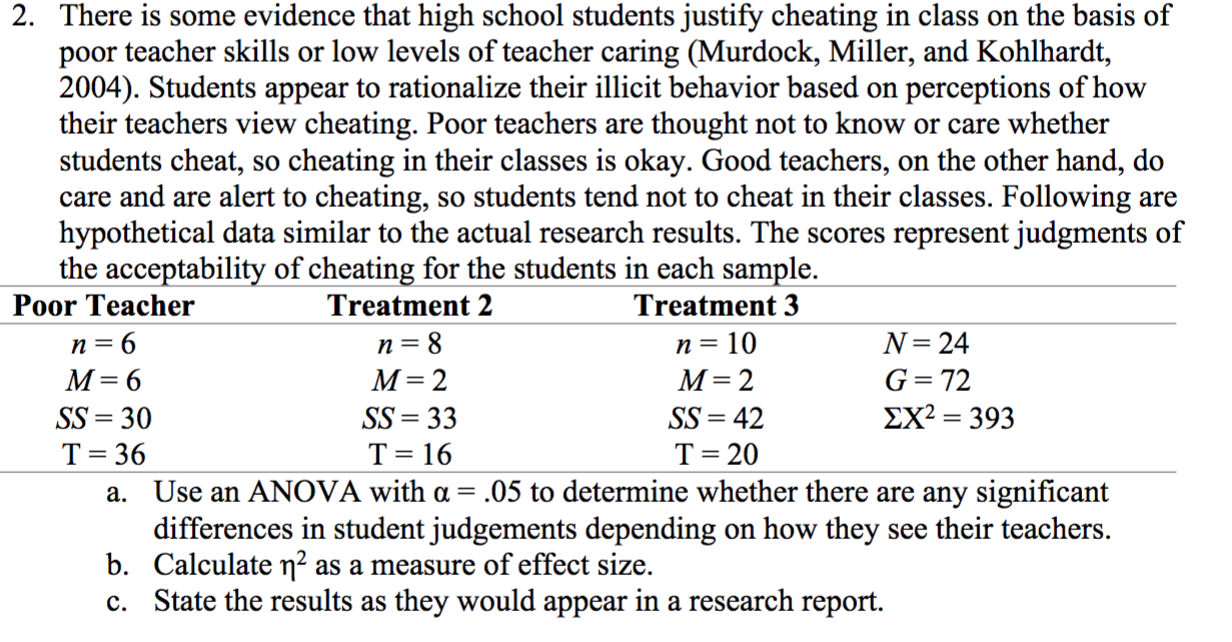2. There is some evidence that high school students justify cheating in class on the basis of poor teacher skills or low levels of teacher caring (Murdock, Miller, and Kohlhardt, 2004). Students appear to rationalize their illicit behavior based on perceptions of how their teachers view cheating. Poor teachers are thought not to know or care whether students cheat, so cheating in their classes is okay. Good teachers, on the other hand, do care and are alert to cheating, so students tend not to cheat in their classes. Following are hypothetical data similar to the actual research results. The scores represent judgments of the acceptability of cheating for the students in each sample. Poor Teacher Treatment 2 Treatment 3 n = 8 M=2 n= 6 n = 10 N= 24 M= 6 M=2 G=72 SS = 30 SS = 33 SS = 42 ΣΧ393 T= 36 T= 16 T= 20 || a. Use an ANOVA with a = .05 to determine whether there are any significant differences in student judgements depending on how they see their teachers. b. Calculate n² as a measure of effect size. c. State the results as they would appear in a research report.
2. There is some evidence that high school students justify cheating in class on the basis of poor teacher skills or low levels of teacher caring (Murdock, Miller, and Kohlhardt, 2004). Students appear to rationalize their illicit behavior based on perceptions of how their teachers view cheating. Poor teachers are thought not to know or care whether students cheat, so cheating in their classes is okay. Good teachers, on the other hand, do care and are alert to cheating, so students tend not to cheat in their classes. Following are hypothetical data similar to the actual research results. The scores represent judgments of the acceptability of cheating for the students in each sample. Poor Teacher Treatment 2 Treatment 3 n = 8 M=2 n= 6 n = 10 N= 24 M= 6 M=2 G=72 SS = 30 SS = 33 SS = 42 ΣΧ393 T= 36 T= 16 T= 20 || a. Use an ANOVA with a = .05 to determine whether there are any significant differences in student judgements depending on how they see their teachers. b. Calculate n² as a measure of effect size. c. State the results as they would appear in a research report.
Glencoe Algebra 1, Student Edition, 9780079039897, 0079039898, 2018
18th Edition
ISBN:9780079039897
Author:Carter
Publisher:Carter
Chapter10: Statistics
Section10.6: Summarizing Categorical Data
Problem 27PPS
Related questions
Question

Transcribed Image Text:2. There is some evidence that high school students justify cheating in class on the basis of
poor teacher skills or low levels of teacher caring (Murdock, Miller, and Kohlhardt,
2004). Students appear to rationalize their illicit behavior based on perceptions of how
their teachers view cheating. Poor teachers are thought not to know or care whether
students cheat, so cheating in their classes is okay. Good teachers, on the other hand, do
care and are alert to cheating, so students tend not to cheat in their classes. Following are
hypothetical data similar to the actual research results. The scores represent judgments of
the acceptability of cheating for the students in each sample.
Poor Teacher
Treatment 2
Treatment 3
n = 8
M=2
n= 6
n = 10
N= 24
M= 6
M=2
G=72
SS = 30
SS = 33
SS = 42
ΣΧ393
T= 36
T= 16
T= 20
||
a. Use an ANOVA with a = .05 to determine whether there are any significant
differences in student judgements depending on how they see their teachers.
b. Calculate n² as a measure of effect size.
c. State the results as they would appear in a research report.
Expert Solution
This question has been solved!
Explore an expertly crafted, step-by-step solution for a thorough understanding of key concepts.
This is a popular solution!
Trending now
This is a popular solution!
Step by step
Solved in 3 steps with 7 images

Knowledge Booster
Learn more about
Need a deep-dive on the concept behind this application? Look no further. Learn more about this topic, statistics and related others by exploring similar questions and additional content below.Recommended textbooks for you

Glencoe Algebra 1, Student Edition, 9780079039897…
Algebra
ISBN:
9780079039897
Author:
Carter
Publisher:
McGraw Hill

Glencoe Algebra 1, Student Edition, 9780079039897…
Algebra
ISBN:
9780079039897
Author:
Carter
Publisher:
McGraw Hill